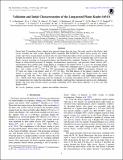Validation and Initial Characterization of the Long-period Planet Kepler-1654 b
Author(s)
Beichman, C. A.; Giles, H. A. C.; Akeson, R.; Ciardi, D.; Christiansen, J.; Isaacson, H.; Marcy, G. M.; Sinukoff, E.; Greene, T.; Fortney, J. J.; Hu, R.; Howard, A. W.; Petigura, E. A.; Knutson, H. A.; Crossfield, Ian Jm; ... Show more Show less
DownloadBeichman_2018_AJ_155_158.pdf (1.197Mb)
Terms of use
Metadata
Show full item recordAbstract
Fewer than 20 transiting Kepler planets have periods longer than one year. Our early search of the Kepler light curves revealed one such system, Kepler-1654b (originally KIC 8410697b), which shows exactly two transit events and whose second transit occurred only five days before the failure of the second of two reaction wheels brought the primary Kepler mission to an end. A number of authors have also examined light curves from the Kepler mission searching for long-period planets and identified this candidate. Starting in 2014 September, we began an observational program of imaging, reconnaissance spectroscopy, and precision radial velocity (RV) measurements that confirm with a high degree of confidence that Kepler-1654b is a bona fide transiting planet orbiting a mature G5V star (T[subscript eff] = 5580 K, [Fe/H] = -0.08) with a semimajor axis of 2.03 au, a period of 1047.84 days, and a radius of 0.82 ±0.02 R Jup. RV measurements using Keck's HIRES spectrometer obtained over 2.5 years set a limit to the planet's mass of <0.5 (3σ) M[subscript Jup]. The bulk density of the planet is similar to that of Saturn or possibly lower. We assess the suitability of temperate gas giants like Kepler-1654b for transit spectroscopy with the James Webb Space Telescope, as their relatively cold equilibrium temperatures (T[subscript pl] ∼ 200 K) make them interesting from the standpoint of exoplanet atmospheric physics. Unfortunately, these low temperatures also make the atmospheric scale heights small and thus transmission spectroscopy challenging. Finally, the long time between transits can make scheduling JWST observations difficult - as is the case with Kepler-1654b. Key words: planetary systems – planets and satellites: detection
Date issued
2018-03-20Department
Massachusetts Institute of Technology. Department of PhysicsJournal
The Astronomical Journal
Publisher
American Astronomical Society
Citation
Beichman, C. A. et al. “Validation and Initial Characterization of the Long-Period Planet Kepler-1654 b.” The Astronomical Journal 155, no. 4 (March 19, 2018): 158. © 2018 The American Astronomical Society
Version: Final published version
ISSN
1538-3881